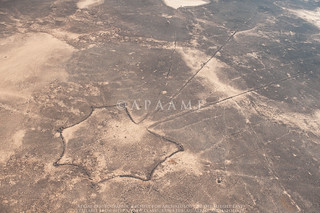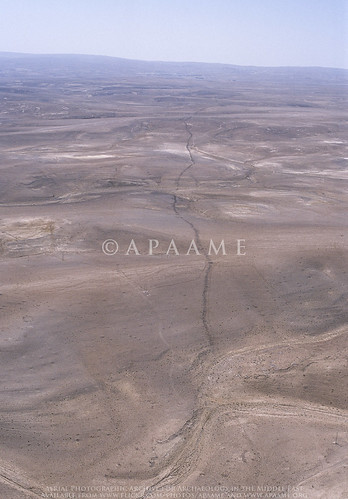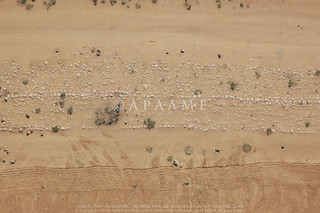There is no question that the word “unexpected” is the theme of this year’s season, which has been very successful so far. Unexpected length of annual holidays and holidays for parliamentary elections, and unexpected (and sometimes inexplicable) restrictions on when and where we can fly. None of this is a surprise; after 20 years of working in Jordan the plans we make before we arrive are always changed, but to the eternal credit of the Air Force, pilots and crews, we always achieve the vast majority of what we plan.
 |
| Landscape of the Wadi Araba, north of Aqaba. David Kennedy, APAAME_20160918_DLK-0399. |
Our opening expedition (18-19 September) was south to Aqaba, but with the unexpected delay following the return to work after the Eid al-Adha, a stronger than expected headwind, and a sick crew man. However despite this we succeeded in flying for over 5 and a half hours, and still had just enough time at the end of the day for a therapeutic swim in the Red Sea, before flying a full four hours back to Amman the following day.
 |
| Wadi an Nasifah. Robert Bewley, APAAME_20160919_RHB-0117. |
Expected, but always surprising, is the number and nature of landscapes and sites we photograph. The trip home from Aqaba took us through narrow steep-sided gorges, with strategically located Roman military installations though to dramatic and contrasting geological formations with a variety of prehistoric, Roman and early Islamic sites.
 |
| A village on the southern edge of the Ras en-Naqb. Robert Bewley, APAAME_20160919_RHB-0161. |
After a brief respite we had two excellent days in the black basalt desert (the Badia) photographing a wide range of sites. The one site that stood out for me - the “Bulls-eye” Cairn. I don’t remember seeing them as clearly defined as those we surveyed this year. The “Bulls-eye” Cairn is another example of just how little we know about the date, distribution or function of many of these sites. However the information we have accumulated means we can start to analyse them, and answer research questions.
 |
| A large 'Bulls-eye' cairn with tail, known also as a 'Pendant'. Robert Bewley, APAAME_20160922_RHB-0538. |
As with the work of the
National Mapping Programme in England, the contribution of aerial survey and interpretation has been to expand our understanding of the size and nature of the past human populations. Seeing the density of stone structures of all types, representing settlements, hunting sites, and burials, has to mean that in the majority of prehistory there were a sizeable human population in the badia desert region of Jordan. An area, until recently, which has been ignored by archaeologists, looking for richer pickings in the so-called Fertile Crescent; thankfully this is changing and there a number of expeditions working in this region to discover the nature of the sites, their date and function. You can see an example of the contribution of aerial survey in the Badia in this article about Bernd Müller-Neuhof's research:
6,000-year-old Fortresses Found in Jordan Show Surprisingly Advanced Early Society.
 |
| Concentration of features on the summit of 'Tell el-Ghusein'. Robert Bewley, APAAME_20160922_RHB-0604. |
It is always an exciting event to be flying in the rift valley along the shores of the Dead Sea, where our fifth flight was located. I don’t usually have the time or inclination to check the altimeter on the GPS but for some reason I clicked on it as we descended from 5,000 ft amsl (above mean sea level) to minus 500 ft, below it.
 |
| Our GPS reading -194 feet below mean sea level. |
Most fittingly, we were flying over the
Museum at the Lowest Place on Earth. This, of course, should be impossible without going under water, but as it is a “mean sea level” which gives us our height, there has to be exceptions. The Dead Sea area as the lowest point on earth (not under water) is one such exception, so we had the unexpected pleasure of flying along at minus 500ft, with the door open and a wonderful (warm) view of this part of the great rift valley.
 |
| View of the Rift Valley. Rebecca Banks, APAAME_20160927_REB-0072. |
We were also, unexpectedly, approached by a journalist from Associated Press (AP), based in Amman. He has interviewed both David Kennedy and I, and I took him flying for a short trip to show the preparation and process of aerial survey. We look forward to seeing his short film in due course. On this short flight we also had (pre take-off) the unexpected pleasure of a flat battery in the helicopter; external power was wheeled in and we were on our way without much delay.
We are now using a different helicopter, no longer the Huey, but now the Eurocopter or ‘EC’. This has meant getting to know a new squadron, and new pilots. Each day it is a new crew. Sitting having tea after one sortie, high up in the control tower of one of airbases the Captain unexpectedly asked me, slightly reluctantly, “Why are you doing this work?” Behind the question (given a certain lack of interest up to that point) was the inference “it seems to be a complete waste of time.” I explained our reasons, - discovering sites, monitoring change and damage, and making a photographic record. On the next sortie he was able to the see sites in a new light and his orbiting was much more precise. Unfortunately we had another 4 hours of flying and by the end of it the crew were exhausted (as were we) and any positive feelings to archaeology were forgotten for the day.
We have had enthusiastic crew members taking pictures out of the window of archaeological sites and the beautiful Jordanian landscape (and maybe their home villages), but also unexpectedly many, many photographs on the ground, including “selfies.” I am not an enthusiast of the “selfie” phenomenon. I have been surprised by the sophistication of the “selfie world” with extending selfie sticks, the use of sun and shade, and location: a selfie with the helicopter in the background must clearly carry some weight in the purpose for which these photographs are taken (if indeed there is one). Who knows, one day we might even have a selfie album on APAAME, but I hope not.
 |
| The dreaded 'selfie stick'. |
Unexpectedly our own health came into play to a greater degree than ever before. Aerial reconnaissance requires strength of both body and mind. The weaker either one of those is the stronger the other has to be. It is rare, here, to have full strength in both, either through lack of sleep (dogs barking in the night, the 0400 call to prayer all contributing to short nights) or the after effect of something we’ve eaten, having a devastating effect on one’s digestion. Each member of the team has succumbed, one way or another, to a bug. This has never happened before and we hope for all our sakes it doesn’t happen again. Fortunately, so far, it has not affected the performance of our well planned (with unexpected changes) flying and making new discoveries.
Less than a week to go, so let us hope for less of the unexpected.
Bob Bewley
28th September 2016
























